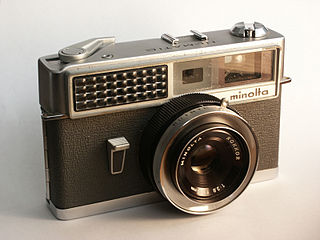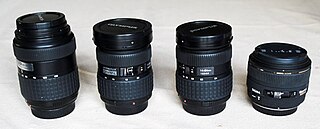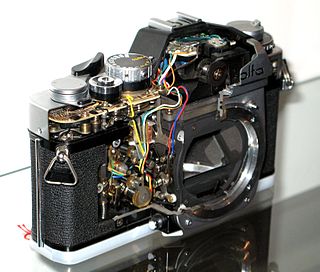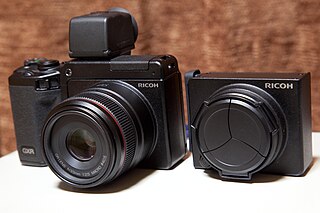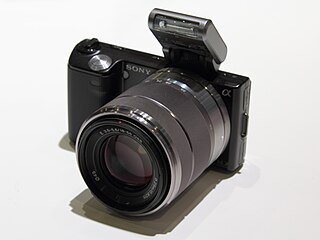| 7Hi/7i |
| CCD | ICX282AQF
2/3-type interline interlaced primary-color Super HAD CCD
Total pixels: approx. 5.24 million
Number of effective pixels: approx. 5.07 million
Number of active pixels: approx. 5.02 million
Chip size: 9.74 mm (H) × 7.96 mm (V)
Unit cell size: 3.4 μm (H) × 3.4 μm (V)
Saturation signal: 450 mV
Sensitivity: 270 mV (G signal, 3200 K, 706 cd/m2, F5.6, 1/30 s accumulation)
Dark signal: 16 mV (Ta=60 °C, 3.75 frame/s)
Smear: −92 dB (without a mechanical shutter, frame readout mode) |
| Image processing | CxProcess |
| Operating system | pSOSystem/MIPS 2.5.x |
| Camera sensitivity | JPEG, TIFF, Motion JPEG (MOV): Auto (100–400), ISO 100, 200, 400, 800 equivalents
RAW: ISO 100 equivalent |
| Aspect ratio | 4:3 |
| Lens construction | 16 elements in 13 groups (includes two AD glass elements and two aspheric elements) |
| Maximum aperture | f/2.8 – f/3.5 |
| Aperture steps | f/2.8, 3.5, 4, 4.5, 5.6, 6.7, 8, 9.5 |
| Focal length | 7.2 – 50.8 mm (35 mm equivalent: 28 – 200 mm)
Macro: 7.2 and 43 – 50.8 mm (35 mm equivalent: 28 and 170 – 200 mm) |
| Focusing range (from CCD) | 0.5 m / 19.7 inch to infinity
Macro: Wide 30 – 60 cm / 11.8 – 23.6 inch, Telephoto 25 – 60 cm / 9.8 – 23.6 inch |
| Maximum magnification | 0.177× (equivalent to 0.7× in 35 mm format) (With a focal length of 50.8 mm. Distance at 25 cm)
Area covered at maximum magnification: 50 × 37 mm / 2 × 1.5 inch (approx.) |
| Optical zooming control | Manual zooming ring |
| Optical focus control | Precision Focus-by-wire rotating focusing ring |
| Autofocus system | Video AF |
| Focus lock | By pressing shutter-release button partway down.
Also possible with spot-AE lock button (The function of the spot-AE lock button can be changed with the recording menu) |
| Autofocus areas | Wide focus area, Spot focus point - Flex Focus Point control with spot focus point mode
|
| Focus modes | Autofocus: Single-shot AF (DMF), Continuous AF (DMF)
Manual focus - DMF - Direct Manual Focus
|
| Focus features | Pixel binning in low light conditions
Center scan mode for 4× electronic zoom image (EVF/LCD, manual focus)
2× digital zoom (LCD, manual focus) |
| Exposure modes | P (Programmed AE) (with program shift), A (Aperture priority), S (shutter priority), M (manual). |
| AE lock | With Spot-AE lock button or by pressing the shutter-release button partway down |
| Metering | Multi-segment (300 segments), center-weighted, Spot |
| Exposure control range | P / A modes: Wide; Ev – 1 – 18, Telephoto; Ev – 0.4 (7Hi) / 1.6 (7i) – 18.7
S / M modes: Wide; Ev – 1 – 17, Telephoto; Ev – 0.4 (7Hi) / 1.6 (7i) – 17.7 |
| shutter | CCD electronic shutter and mechanical shutter |
| shutter speed range | 7Hi: 15 - 1/4000 seconds (in P / A modes, ISO 100), Bulb (max. 30 seconds)
7i: 4 – 1/4000 seconds (in P / A modes), 4 – 1/2000 seconds (in S / M modes), Bulb (max. 30 seconds) |
| White-balance control | 7Hi: Automatic, Preset {Daylight, Tungsten, Fluorescent 1, 2 (white / cool white), Cloudy}, Custom (3 positions)
7i: Automatic, Preset (Daylight, Tungsten, Fluorescent, Cloudy), Custom |
| Digital Subject Programs | Portrait, Sports action, Sunset, Night portrait, Text |
| Digital Effects Control | Exposure, Color saturation, Contrast compensation, Filter |
| Exposure compensation | +/− 2 Ev in 1/3 increments |
| Flash metering | ADI, Pre-flash TTL, Manual flash control - ADI - Advanced Distance Integration
|
| Flash-sync speeds | All shutter speeds |
| Flash modes | Fill-flash, Red-eye reduction, Rear flash sync, Wireless / Remote flash |
| Built-in flash range* (approx.) | | ISO setting | Flash range (wide angle) | Flash range (telephoto) | | AUTO | 0.5 m – 3.8 m / 1.6 ft – 12.5 ft | 0.5 m – 3.0 m / 1.6 ft – 9.8 ft | | 100 | 0.5 m – 2.7 m / 1.6 ft – 8.8 ft | 0.5 m – 2.1 m / 1.6 ft – 6.9 ft | | 200 | 0.5 m – 3.8 m / 1.6 ft – 12.5 ft | 0.5 m – 3.0 m / 1.6 ft – 9.8 ft | | 400 | 0.5 m – 5.4 m / 1.6 ft – 17.6 ft | 0.5 m – 4.2 m / 1.6 ft – 13.8 ft | | 800 | 0.5 m – 7.6 m / 1.6 ft – 25 ft | 0.5 m – 6.0 m / 1.6 ft – 19.6 ft |
- When the camera sensitivity is set to auto, the ISO is set between ISO 100 and 200.
- The flash range is measured from CCD.
|
| External flash connection | Accessory shoe
Flash sync terminal (7Hi) |
| Recycling time | 7 seconds (approx.) |
| Flash compensation | +/−2 Ev in 1/3 increments |
| Viewfinder type | EVF (Electronic viewfinder), Variable-position: 0–90 degrees
Automatic monitor amplification, electronic magnification for manual focusing |
| Viewfinder display | 4.8 mm (0.19 inch) Ferroelectric reflective liquid crystal microdisplay
Equivalent visual resolution: 220,000 pixels (approx.), field of view: 100% (approx.)
Display format: 300 (H) × 224 (V)
Pixel dimensions: 0.0135 mm (pixel dimensions include a 0.0005 mm interpixel gap)
Color depth: 18 bits (6-bit RGB)
Brightness: 250 cd/m2
Contrast ratio: 80:1 |
| Viewfinder magnification | 0.31 – 2.1× |
| Diopter control | −5 to +0.5 diopter |
| Eye relief | 20 mm (from eyepiece) |
| LCD monitor | 46 mm (1.8 inch) low-temperature polysilicon TFT color
Total pixels: 118,000, field of view: 100% (approx.)
Number of colors: Analog full color
Pixel arrangement: RGB delta
Effective pixels per unit area: 115.4 dots/mm²
Optical transmittance: 8.6%
Contrast ratio: 200:1 |
| Display format | Recording mode: Live image, Grid, Scale, Quick view, Instant playback, Histogram of live image, Various statuses
Playback mode: Single-frame, Index, Enlarged playback, Slide show, Histogram of recorded image, Various statuses |
| Display-mode switch | Auto-display (Viewfinder proximity sensor), Electronic viewfinder display, LCD-monitor display |
| A/D conversion | 12 bits
Correlated Double Sampling (CDS)
79 dB SNR |
| Camera memory | 7Hi: 64 MB (SDRAM)
7i: 32 MB (SDRAM) |
| File formats | JPEG, TIFF, Motion JPEG (MOV), RAW. DCF 1.0 / DPOF 1.1-compliant |
| Printing output control | 7Hi: Exif Print, PRINT Image Matching II
7i: Exif Print, PRINT Image Matching |
| Recording media | Type I and Type II CompactFlash cards (max. 2 GB) IBM Microdrive (170 MB, 340 MB, 512 MB, 1 GB) |
| Image quality modes | RAW, Super fine (TIFF), Extra-Fine (7Hi), Fine, Standard, Economy (7i) |
| Number of recorded pixels | Still images (JPG): 2560 × 1920, 1600 × 1200, 1280 × 960, 640 × 480
Still images (RAW): 2568 × 1928
Movie clips: 640 × 480 (UHS continuous-advance mode), 320 × 240 (standard, night movie modes), Time-lapse movie at all image sizes |
| Color modes | Natural Color (sRGB), Vivid Color (sRGB), Adobe RGB (7Hi), Black and white (neutral and toned), Solarization |
| Advanced color management | Yes (7hi) - Embedded ICC Profiles are available for all formats except RAW
|
| Sharpness settings | Three levels (Soft, Normal, Hard) |
| File size* (approx.) | | 2560 × 1920 | 1600 × 1200 | 1280 × 960 | 640 × 480 | | Economy | n/a (7Hi) / 670KB (7i) | n/a (7Hi) / 390KB (7i) | n/a (7Hi) / 300KB (7i) | n/a (7Hi) / 160KB (7i) | | Standard | 1.5 MB (7Hi) / 1.1 MB (7i) | 660 KB (7Hi) / 620 KB (7i) | 460 KB (7Hi) / 420 KB (7i) | 240 KB (7Hi) / 200 KB (7i) | | Fine | 2.5 MB (7Hi) / 2.1 MB (7i) | 1.0 MB (7Hi) / 1.0 MB (7i) | 720 KB (7Hi) / 680 KB (7i) | 320 KB (7Hi) / 280 KB (7i) | | Extra Fine | 4.8 MB (7Hi) / n/a (7i) | 1.9 MB (7Hi) / n/a (7i) | 1.3 MB (7Hi) / n/a (7i) | 420 KB (7Hi) / n/a (7i) | | Super Fine | 14.2 MB (7Hi) / 14.1 MB (7i) | 5.6 MB (7Hi) / 5.6 MB (7i) | 3.6 MB (7Hi) / 3.6 MB (7i) | 1.0 MB (7Hi) / 980 KB (7i) | | RAW | 9.6 MB (7Hi) / 9.5 MB(7i) | n/a | n/a | n/a | | Movie | 297 KByte/second (7Hi) / 250 KByte/second (7i) |
- Numerical value may vary depending upon the subject.
|
| Continuous advance | Modes :
High Speed continuous advance (with 2560 × 1920 size images) (7Hi)
UHS (Ultra High Speed) continuous advance (with 1280 × 960 size images)
Standard continuous advance - UHS and standard continuous advance cannot be used with Super Fine or RAW images.
Speeds :
High Speed continuous advance: max. 3 frame/s (approx.) (7Hi)
UHS (Ultra High Speed) continuous advance: 7 frame/s (approx.)
Standard continuous advance: max. 2 frame/s
- Actual speeds may vary depending upon subjects and shooting conditions.
|
| Interval recording | 2 – 99 frames. Interval time: 1 – 10 / 15 / 20 / 30 / 45 / 60 minutes |
| Digital Enhanced Bracketing | Exposure, Contrast, Color saturation, Filter
Exposure: 1.0, 0.5, 0.3 Ev increments
Contrast, Color saturation, Filter: fixed increments
Number of brackets: 3 frames |
| Self-timer | 10 seconds (approx.) |
| Movie recording | Standard movie mode:
60 s (max.) with and without monaural audio
Number of recorded pixels: 320 × 240
Frame rate: 15 frame/s Night movie mode (Images is monochrome.):
60 s (max.) with and without monaural audio
Number of recorded pixels: 320 × 240
Frame rate: 15 frame/s UHS (Ultra High Speed) continuous-advance movie mode:
Number of recorded pixels: 640 × 480
Frame rate: approx. 7 frame/s without audio Time-lapse movie mode:
Number of recorded pixels: 2560 × 1920, 1600 × 1200, 1280 × 960, 640 × 480
Frame rate: 4 frame/s without audio |
| Audio | Voice memo: 5 or 15 seconds monaural audio with still image
File format: WAVE |
| Audio signals | Two tones and two shutter sound effect settings |
| Exif tag information | Date and time, Camera settings: Exposure mode, shutter speed, Aperture value, Exposure compensation value, Metering method, Flash on / off, Camera sensitivity, White balance setting, Focal length, etc. |
| Delete function | Single, multiple, or all frames can be deleted |
| Format function | Available in the Play mode |
| Data imprinting | Year / month / day or Month / day / time, Text, Text and serial numbers |
| Digital zoom | 2× |
| Dark frame subtraction | Yes in Bulb |
| Customizable interface | Yes (7hi) |
| Batteries | Four AA Ni-MH or alkaline batteries (Use of Ni-MH batteries is recommended.) |
| Battery performance (approx.) (Minolta measurement*) | Number of recording: 220 frames
Continuous playback time: 120 minutes - 1700 mAh Ni-MH batteries, EVF on, external LCD monitor off, full-size images (2560 × 1920), Standard image quality, No instant playback, No voice memo, flash used with 50% of the frames
|
| Operating time (approx.) | Start-up time: approx. 3 seconds
shutter release time lag: 0.1 – 0.17 second |
| External power source | 6 V DC (with specified AC adapter AC-1L or AC-2L); current rating: 2 A |
| PC interface | USB 1.1 |
| AV output | PAL / NTSC |
| Dimensions (W×H×D) | 117 × 90.5 × 112.5 mm / 4.6 × 3.6 × 4.4 inch |
| Weight | 7Hi: 530 g / 18.7 ounce
7i: 525 g / 18.5 ounce
without batteries or recording media |
| Standard accessories | Leather neck strap NS-DG1000 (7Hi), Neck Strap NS-DG7 (7i), Lens cap (49 mm) LF-1249, Accessory Shoe Cap SC-9, AV cable AVC-300, CF (CompactFlash) card (16MB), USB cable USB-100, DiMAGE Software CD-ROM (Includes DiMAGE Viewer), Lens Shade DLS-7Hi (7Hi), Lens Shade DLS-7i (7i), Four AA Ni-MH batteries, Ni-MH battery charger - Availability of accessories depends on areas.
|







